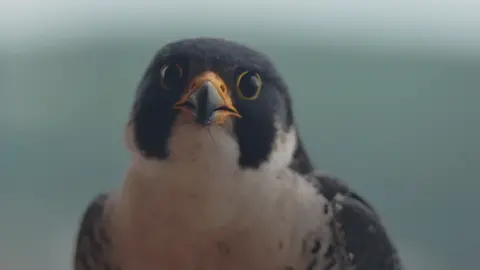Peak District bird of prey scheme ends as wildlife crime continues
 Getty Images
Getty ImagesA project set up to protect and increase the number of birds of prey in the Peak District is being wound up.
The Peak District Bird of Prey Initiative began in 2011 to restore bird populations to 1990s levels.
However the Peak District National Park Authority (PDNA) said continuing wildlife crime, and some of the scheme's participants deciding to pull out, had led to the decision to end it.
It said the scheme no longer delivered "meaningful change".
The initiative had hoped to restore the breeding populations of iconic species such as the peregrine, goshawk and merlin.
It did succeed in restoring sightings of hen harriers, red kites and ospreys by working with landowners, gamekeepers, the police and conservation experts.
But the PDNA said many key species had not increased at the rates initially hoped for, with some seeing no improvement at all.
A PDNA spokesperson said: "The decision to close the initiative... follows both a lack of progress in achieving the populations of key species targeted on its initiation over a decade ago, and continued cases of persecution incidents, both reported and confirmed within the National Park.
"In addition, other partners had indicated their intention to withdraw from the initiative meaning that, in the authority's view, the initiative was no longer viable."
The PDNA said the RSPB had quit the initiative in 2018.
It said a group of volunteers had also recently stated they felt they could no longer continue their support.
Phil Mulligan, chief executive of the PDNA, said: "It is with regret that we are closing the initiative after more than a decade of endeavours to safeguard our charismatic birds of prey that have a rightful place here in the National Park.
"Featuring at the very top of local ecosystems, these species like the hen harrier, peregrine and goshawk should be a flagship for landscapes and habitats at the heart of nature's recovery.
"The fact that the work of the initiative has failed to reflect those target populations of some 30 years ago remains a cause for real concern and it is without question that illegal persecution targeted towards some of these species is one factor behind this stuttering progress."
He thanked those who had participated in the scheme over the years and said the authority would continue working to protect birds of prey in the Peak District.
 Getty Images
Getty ImagesHowever one of the participants - the Moorland Association - said it had been successful.
Director Amanda Anderson said: "While some species may not have recovered to the number recorded in 1990, they are all present and fledging young, while other populations have expanded significantly as highlighted by Natural England's Breeding Birds survey."
She said sightings of buzzards, kestrels and harriers had risen between 1990 and 2018.
She added: "When failures among species occur it is disappointing for all involved, but we believe that land managers should be at the heart of conserving habitats to encourage birds of prey, working with the police as partners.
"The long term trend is improvement in occupied territories or fledging success, with a reduction in confirmed persecution incidents. It makes no sense to walk away now."
Derbyshire Police has been contacted for comment.

Follow BBC East Midlands on Facebook, on Twitter, or on Instagram. Send your story ideas to [email protected].
